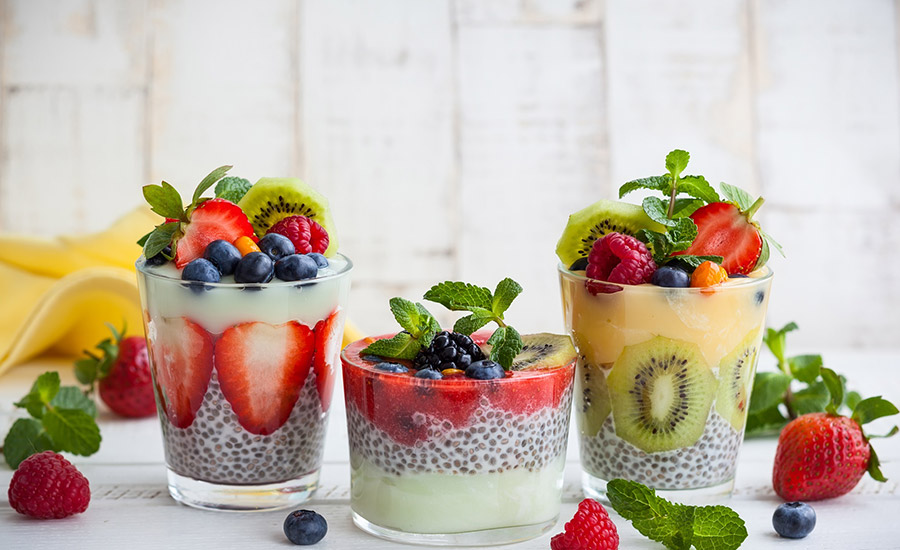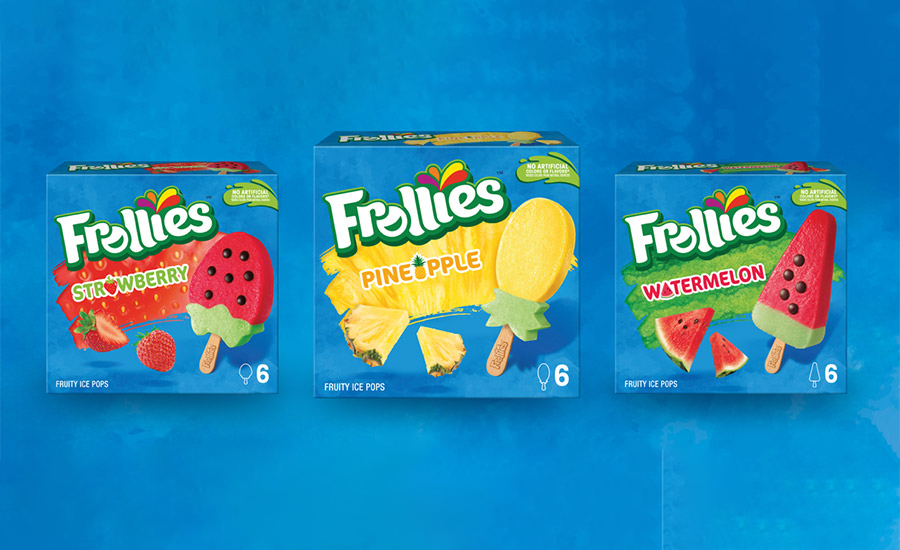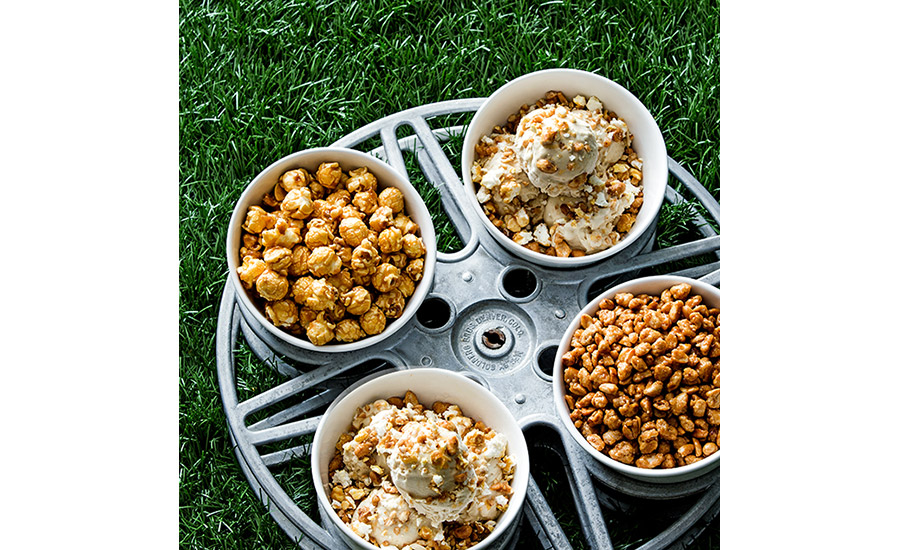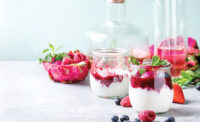Fruits, nuts and inclusions slated to drive market growth to $18.7B by 2027
Consumers look for indulgence, flavor, color, and crunch in yogurt, ice cream, and more.

Photo courtesy of Pecan Deluxe Candy Co.
The food inclusions market — split into chocolate chips and chunks, candy pieces, fruits and nuts, herbs, spices, and even savory ingredients like cheese or bacon bits — is thriving based on demand for value-added food products and significantly wider application in dairy products, ice cream, frozen desserts, confectionary, baked products, and snacks and bars.
In fact, food and beverage manufacturers are investing in new product development as the food inclusions market, valued at $13.4 billion in the U.S. in 2022, is projected to reach $18.7 billion by 2027, with a compound annual growth rate (CAGR) of 6.9%, states New York-based Market Research Future.
In addition, growing preferences for healthy and tasty food products may serve as an opportunity for market growth, but at the same time the market research firm cautions that the high cost associated with raw materials may restrain market growth.
When it comes to market share, fruits and nuts, at 27.5%, command significant market share and are likely to grow at a CAGR of 6.8%, the report states. Kalamazoo, Mich.-based FlavorSum’s Phil a’Becket notes that chocolate inclusions retain the largest share; however, fruits and nuts are registering a higher CAGR.
“Caramel and other sugar-based inclusions round out the balance of the market,” the senior consumer insights manager states. “Beyond adding complexity to flavor, visual appeal and texture, the nutritional value of food inclusions is contributing to increased interest. The functional benefits of fruits, seeds and nuts (e.g., energy, protein, vitamins) boosts demand, especially when paired with the convenience of ready-to-eat dairy products like yogurt.”
Amanda Cardinal, marketing coordinator at Dallas-based Pecan Deluxe Candy Co., concurs that yogurt is “leading the charge,” with such flavor innovations as strawberry and lime paired with crunchy additions such as praline almonds or cranberry granola to create deconstructed dessert-like experiences.
Yet, dairy inclusions are more than a one-trick pony, as in addition to yogurt, they’re being used in puddings, ice cream, cream cheese, cheese and frozen novelties. On the plant side, plant-based sour creams and cream cheeses also are innovating in this space.
“These mix-ins also breathe new life into products that might have appealed more to older generations, making them more attractive to younger consumers looking for convenient and fun snacking options,” Cardinal explains. “In non-dairy categories, plant-based options like oat milk and almond milk are well-established, but innovations in these areas are also continuing to grow, especially for consumers who are seeking alternative dairy-free options with similar texture and flavor profiles.”
Heidi Clark, national sales and marketing manager at Nampa, Idaho-based MicroDried, notes that “Ice cream, yogurt, and frozen novelties are major categories incorporating fruits and nuts. Hard cheeses, such as cheddar with dried cranberries, and plant-based products like almond-based cream cheese, are also innovating with these inclusions. Drinkable yogurts and cottage cheese cups are thriving with functional and flavorful additions.”

Key trends within dairy and non-dairy inclusions include health-conscious snacking, clean-label preferences and hybrid flavor profiles, Clark adds.
“Common ingredients include blueberries, cranberries, honey and nuts, which enhance sales in frozen novelties, yogurt parfaits, and even premium ice cream. Hybrid sweet-savory profiles, such as fig and walnut or pomegranate and honey, are gaining traction in both dairy and non-dairy products,” she says.
Increasing consumer preferences for fat-free and healthy foods is encouraging dairy manufacturers to include healthy ingredients in food inclusions. While fresh fruit pieces are healthier because they contain more water, fiber and are naturally lower in calories and sugar, dried fruits can still be a part of a healthy diet when consumed in moderation and without added sugar, according to WebMD.
“By weight, dried fruit contains up to 3.5 times the fiber, vitamins and minerals of fresh fruit,” WebMD states.

A February 2023 report, “The Dried Fruit Market” from Dublin-based ResearchAndMarkets, predicts that the dried fruit market will surge at a CAGR of nearly 5% from a market value of $37 billion in 2020 to $51.5 billion by the end of 2027. Among the benefits of dried fruits are their ability to be preserved for a longer duration than fresh fruits, which requires no refrigeration, prolongs shelf life and serves as handy snacks.
Fueling market demand
“Dried fruits are consumed worldwide due to their health benefits,” ResearchAndMarkets states, noting that the growing food inclusion market will positively impact growth of the global dried fruits market.
There also are ample products to choose from, including nutrient-dense raisins, dates, prunes, figs and apricots, while sugar-coated, candied inclusions comprise dried mangoes, cranberries and apples.
“Dry fruit is formed through drying methods where almost all the water content of fresh fruit is removed, and this shrinks the food product resulting in small, dense-dried fruit,” the market research firm states. “Studies have suggested that dried fruits are a source of nutrients, including antioxidants, fiber, and vitamins. For example, raisins may help in lowering blood pressure and improvement in blood sugar control as it has a low-to-medium glycemic index value and a low insulin index.”
FlavorSum’s Kelsey Cheadle, who serves as a senior dairy applications scientist, notes that within cultured yogurts, sweet fruits balance the tangy flavor of the base. Yet, “Incorporating inclusions in dairy products is challenging because they can affect the overall texture, flavor profile, and shelf life of the final product,” Cheadle says, noting the functionality of many food inclusions that are rich in proteins, essential fatty acids, vitamins and fiber.
“Some brands (dairy and plant-based) are incorporating more seeds into dairy products like yogurt for additional functional benefits. For example, chia seeds provide additional protein, fiber, calcium, phosphorus, antioxidants derived from phenolic compounds, and α-linolenic F.A. (omega 3),” she explains. “Flax seeds contain soluble fiber that can help with the absorption of nutrients and contribute to digestive health. The seeds also have lignans with unique antioxidant properties. Pumpkin and sunflower seeds offer protein, healthy fats, fiber, antioxidants, vitamins and minerals. Combining pumpkin or sunflower seeds with yogurt’s protein may help with satiety and blood sugar stability.”

Nuts and seeds aren’t the only inclusions dairy processors are incorporating. The fillings and toppings market, valued at nearly $12 billion in 2022, is projected to reach nearly $16 billion by 2027, growing at an annual CAGR of 6%, according to MarketsandMarkets. The fastest growing segment are creams such as cream fillings in chocolate products like creamy caramels, chocolate, chocolate mint and orange.
Fruits, fillings bring functionality
Since innovation in new flavors and healthy ingredients are driving inclusions’ market growth, fruit flavors, provided by fruit syrups, fruit sauces, fruit powders, or by using fruits in different forms such as sliced, whole, dried, chopped, and pieces, provide fresh fruit taste in any season with a bright color, lush texture, and attractive appearance.
Kami Smith, director of culinary showcasing at Pecan Deluxe, notes that not only does fruit in a snack bite offer delicious taste, but “it provides amazing natural color, tart or sweet levels, that quench the little cravings, meanwhile providing a power punch of vitamins and minerals that promote health and wellness for the body.
”The same goes for nuts. Whether you’re a pecan lover or hazelnut enthusiast, one thing is certain, these little nibbles are chopped full of unsaturated fats, fiber, protein, and a smattering of minerals that are vital for the body systems to be in harmonious function,” Smith continues. “The emphasis of health and wellness versus indulgence is available — and though refined sugars in high volumes isn’t great, one can be assured in knowing a small dose of rich, indulgent snacks when paired with the healthy bits is fine. Who knew one could have their cake and eat it too?”

Season of newness
New products with fruits, nuts, and other inclusions like granola are hitting grocery stores. In January, Dreyer’s launched Frollies, a line of 60-calorie ice pops aimed at consumers “looking to break free from boring,” the Walnut Creek, Calif.-based company says. Made with real fruit juices and purees with no artificial flavors or colors, the “frozen fruity lollies” are intended to evoke childlike wonder with its creamy, fruity, melt-in-your-mouth, sorbet-like textures and playful shapes.
The gluten-free frozen, fruity ice pops are available in three flavors: Watermelon, a blend of watermelon and apple water ice topped with chocolatey pieces; Pineapple is paired with tart apple juice; and Strawberry meets apple ice, topped with sweet chocolatey “seeds,” for a burst of sweet deliciousness.
For nearly two years, Magic Spoon has been working on a new product line that has arrived: Magic Spoon Protein Granola. While granola has been around for decades and is often touted as healthy, the New York-based company suggests it’s typically very high in sugar and empty carbs.
In a reinvention of the category, Magic Spoon Protein Granola, available in Honey Almond, Peanut Butter, Mixed Berry and Dark Chocolate Almond, contains 13 to 14g of protein, 7 to 8g of fiber and only 2g of sugar. “Our reimagined granola is packed with protein and fiber, gluten-free, grain-free, low-sugar … all while being deliciously sweet and crunchy,” Magic Spoon co-founder Gabi Lewis says.
As a result of what inclusions offer and in light of the expected growth, ingredient suppliers are helping brands to differentiate themselves. MicroDried offers a range of fruit and vegetable inclusions, including powders, fragments and whole pieces.
“Developed through our proprietary drying process, these ingredients retain vibrant color, flavor and nutritional content. Our low-moisture products are ideal for applications in yogurt, ice cream, cottage cheese, and plant-based cheese spreads and dips,” Clark says.
FlavorSum offers a portfolio of fruit-based variegates including strawberry, huckleberry, blackberry, blueberry and acai along with non-dairy sweet brown variegates (e.g., caramel) and other indulgent profiles (cinnamon, praline, molasses, and caramel fudge).
The company notes it continues to develop new inclusions to align with trends and customer requests. Sourcing-wise, the availability of some fruit inclusions are crop dependent. “For example, the raspberry yield improved in 2024 with better environmental conditions and more planted acreage in response to increased demand. The recovery should help with raspberry pricing,” Cheadle explains.
When using fruit enhanced with flavor in dairy products, Cheadle recommends a flavor that withstands heat and that can be added at the end of the fruit prep cooking process.
Noting that its company “goes crazy for nuts,” Pecan Deluxe was founded in 1950 on providing sweet experiences through technical measures of boiling sugar.
“When mastered, you have a well-oiled machine that produces the most stunning, golden caramelized crusted nut piece ever. We are the master,” Smith says. “… We are based on the beauty of the pecan nutpiece. It still reigns true on the production floor, technical lab, and in our sales discussion, but can now offer fruit and nuts in new ways using our equipment and collectively creating new granolas, cookie doughs, extruded bakery pieces, and even a beverage base that takes one to the daydreaming world of Strawberry Fields.
“We pride ourselves on the excellence of the fruit and the nut, but the reality is, we take greater pride in knowing we can do just about anything the industry needs,” Smith concludes.
Looking for a reprint of this article?
From high-res PDFs to custom plaques, order your copy today!






Raspberry-Frozen-Yogurt-Pops.jpg?height=200&t=1674519047&width=200)